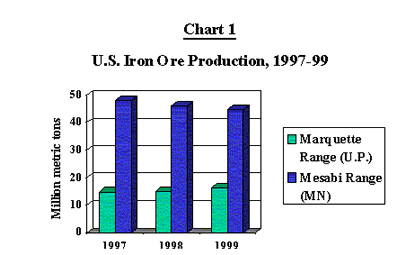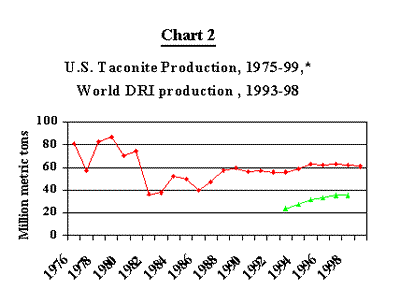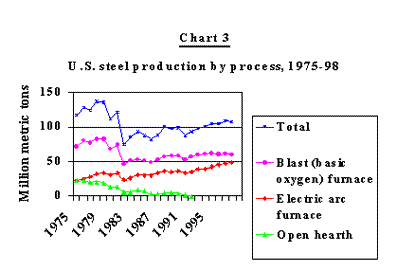Many are the stories of upheaval and hard times that befell iron ore miners and mining companies in northeastern Minnesota and Michigan's Upper Peninsula (U.P.) in the 1980s. Companies scrambled to stay afloat, and 10,000 workers—more than 60 percent of the mining workforce—lost their jobs in Minnesota's mines alone.
Thanks to a doubling of productivity and a handful of other factors since then, iron ore mining is relatively healthy today. Average annual salary in Minnesota mines is $65,000, and the 1990s saw fairly steady demand in an industry dizzied by an up-and-down market the previous two decades.
But there are signs that the iron ore industry is staring straight into the face of upheaval once again—maybe not today, or even tomorrow, but probably sooner than later if it expects continued demand for the annual 60 million metric tons of ore that are currently dug, crushed and pelletized from Minnesota and U.P. mines.
In short, the iron ore industry has historically been tied at the waist, feet and shoulders to the steel industry. The steel industry has gradually evolved into two wagons going at different speeds. Setting aside the current price slump in the steel industry for a look at the bigger picture, it appears Minnesota and U.P. iron mines are tied to the slower wagon.
Seven iron mines in Minnesota's Mesabi Range and two mines in the U.P.'s Marquette Range excavate more than 99 percent of all U.S. iron ore. Virtually all of it is used in blast furnaces at integrated steel mills, most of which are located on or near the Great Lakes. Although far from obsolete or unproductive, problem number one is that blast furnaces are losing market share to electric arc furnaces—which are also known as "mini-mills" because of their smaller size and output. See Chart 1.

Source: U.S. Geological Survey
Problem two, electric arc furnaces can't use the taconite pellets that Minnesota and U.P. mines currently produce because their iron content is too low (about 65 percent). Instead of taconite pellets, mini-mills consume mostly iron and steel scrap, and increased mini-mill production has created a volatile scrap market.
This volatility has created new markets for a kind of processed ore called "direct-reduced iron," or DRI, a loose umbrella term for several ore-based, alternative-iron products used by mini-mills to make steel.
Problem three—an extension of problem two, really—is that new plants must be built in the Mesabi and Marquette ranges that can turn the low-grade ore here into DRI, which has an iron content of about 95 percent. Until that investment happens, Minnesota and U.P. mines are captive suppliers to the half of the steel industry—blast furnaces-seeing little growth and uncertain long-term prospects.
Two proposals for DRI plants are currently on the table to bring DRI production to Minnesota mines. Minnesota Iron and Steel (MIS) is proposing a $1.3 billion project at an abandoned mine in Nashwauk, Minn., that would include a flat-rolled steel mini-mill along with a DRI plant, reportedly making it the first ground-to-steel operation in North America. So far, MIS has raised about two-thirds of the $350 million necessary in equity financing. Officials there have slated start-up by late 2002, assuming the proposal passes environmental and other hurdles along the way.
The DRI proposal is a logical one given today's steel market, according to Ron Dicklich, the company's director of government and public affairs.
"It has all to do with costs," Dicklich said, noting that the proposed MIS superplant would produce a ton of steel more than one-third cheaper than the average integrated steelmaker using blast furnaces.
Another DRI plant is being proposed at the Northshore mine in Virginia, Minn., by Cleveland-Cliffs Inc., a raw material supply company that operates five mines in the U.P. and Minnesota, and is part owner of four of the mines.
Four or five years ago, Cleveland-Cliffs saw that "growth in steel was going to be in the electric side" of the industry, according to Dave Gardner, public relations director for the company. A much smaller project in scope than the MIS proposal, the Northshore DRI project is already knee-deep in the environmental permitting process, Gardner said.
But the company "was still not at any point to make an announcement" about a start-up date, Gardner said. The company recently opened a DRI plant in Trinidad that has been experiencing some mechanical problems, he said, compounded by a DRI market that "just went south in the last year," dropping from $160/ton to about $100/ton, due to a glut of DRI imports.
"We'd have been considerably more worried (about mechanical problems in Trinidad) if we'd have customers hounding us for product," Gardner said. The Northshore proposal is moving forward, but the company's main focus is "to get the (Trinidad) plant running and get a market presence" in DRI, he said.
Where's the fire?
Gripped by a deep industry recession in the 1980s, taconite mines underwent massive restructuring. In the last 15 years, Minnesota mines have invested $1 billion to double productivity, add research capacity and enhance plant technology to bring taconite prices down for its blast furnace customers, according to Ann Glumac, president of the Iron Mining Association of Minnesota.
Taconite mines today are considered highly competitive, and taconite demand has been decent through much of the last decade. "There has always been the need for virgin iron units," Glumac said. "I don't think we'll see the end of the blast furnace for some time."
Gardner agreed, pointing out that blast furnaces "are still the most efficient to produce steel and the highest quality steel."
But electric furnaces are making significant progress, some of it at the expense of blast furnaces. Gardner said that electric furnaces are meeting low-end steel needs with increasing efficiency and are now "starting to compete on high-end product areas."
U.S. steel production grew 16 percent from 1992 to 1998. About 80 percent of that growth has come from electric arc furnaces, whose smaller size has made it financially possible to steadily add capacity and to meet niche demand in the steel market.
More than 40 percent of the 180 or so electric furnace modules in the United States have started up since 1980 (many companies have more than one at a given location). This has pushed annual output up by a similar amount to almost 48 million metric tons, or 45 percent of U.S. steel market, up from 28 percent two decades ago. Much of this increase was assumed from once-dominant open hearth mills that were phased out by the early 1990s. See Chart 2.

U.P. and Minnesota mines = 99 percent of U.S. production
Source: U.S. Geological Study, International Iron and Steel Industry
In contrast, about half of all blast furnaces have closed in the last 20 years, according to Bill Obenchain, director of the American Iron and Steel Institute (AISI). The main obstacle facing blast furnaces in the future is not production obsolescence, but environmental issues related to their dependence on coke (a residue of coal) for fuel, he said.
Despite the drop in numbers, blast furnace steel output has held steady in the last decade at about 60 million metric tons annually, thanks to dramatic productivity improvements. But production is still one-fourth less than its heyday in the 1970s, and the market share of blast furnaces has dropped from over 60 percent to 55 percent in just the last five years. Within 10 to 15 years, electric furnaces are expected to make 60 percent of all steel, according to AISI.
That has left taconite mines on a slippery slope. Total iron ore output had risen by about 10 percent in the last decade, but has been wiped out by the current slump in the steel industry. Taconite demand from U.S. steelmakers has dropped 12 percent year to date through September 1999. Five of Minnesota's seven mines and both U.P. mines have seen production cutbacks as a result, four of which are operated by Cleveland-Cliffs. In November, the company forecast that its 1999 sales would be down by more than 20 percent. See Chart 3.

Sources: U.S. Geological Survey; New Steel, March 1999
"Someone's making more steel," Dicklich said, "and they're doing it without taconite pellets."
A (scrap) heap of trouble
Electric furnaces have been around for decades, designed as a low-cost alternative to making low-grade steel—girders, rebar—and using nothing but scrap iron and steel.
Remelting scrap consumes much less energy than processing iron ore, which makes electric furnace steel very price competitive in the low-end market. But impurities inherent in scrap prevented electric furnaces from producing high-end sheet steel for products like cars and appliances—giving blast furnaces an exclusive market for the industry's highest quality product.
"High quality scrap is hard to come by," according to Blair Benner, program manager of the Coleraine Minerals Research Laboratory in Coleraine, Minn. "It's hard to know what you're actually putting in."
Then a funny thing happened on the way to the scrap yard. Electric furnaces consumed so much scrap they created a scrap shortage. Integrated steel companies assumed that as scrap prices rose, electric furnaces would be less able to compete with blast furnaces on the basis of price.
Rather than just shrug its shoulders, the electric furnace industry looked for a supplemental "feed" from iron ore with higher iron content than taconite pellets, and the DRI commodity market was born.
Maybe more important in the long run, DRI also introduced input consistency to electric furnaces for the first time, which is allowing steel from electric furnaces to compete in the high-end market.
DRI production in the United States today is still in its infancy, which is why electric furnaces here will continue to be fueled by better than 90 percent scrap in the near future. Changes are afoot, however. There are just five DRI plants in the United States, but four of them have started operation in the last three years. Including the two Minnesota proposals, as many as five more are in the works.
But with just 2 percent of the world DRI market in 1998, domestic DRI production has a lot of catching up to do. Since 1990, the number of DRI plants worldwide has risen by 150 percent to almost 90. This infusion of new DRI capacity is a main factor behind recent price slumps. Nonetheless, experts say the long-term market for alternative-iron is good because electric furnace steelmakers are looking to reduce their exposure to a volatile scrap market, while also reaping the benefits of improved input consistency.
Skating to the steel puck?
With taconite mines investing heavily to lower prices to their main customers—blast furnaces—it has left companies with few resources to push into DRI and the iron needs of electric furnaces. Compounding matters is a soft steel market, which in turn has softened demand for taconite.
"Every time there's a (steel) downturn somebody up there (in Minnesota and the U.P.) starts sweating," said Bill Kirk, an iron ore specialist with the U.S. Geological Survey.
Blast furnaces are also supplementing their once-steady diet of taconite with about 10 percent of DRI, according to Obenchain, cutting further into the taconite market.
Dicklich of MIS said that's why their DRI project makes so much sense. "In order for growth, survival and success, [taconite mines] have to get into value-added (products)." Glumac countered that DRI is not an unknown to Minnesota mines. "They've all looked at it at one point or another," she said, adding that the idea of further value-added processing of iron ore has been "the dream of a lot of people for a very long time."
But first, Glumac said, someone has to prove "that Minnesota ore is suitable for this (DRI) process." Industry officials have told her that companies are waiting for someone else to take the risk and figure out how to get started in DRI "and everyone else will follow suit," Glumac said.
Part of the problem in a shift to DRI is that taconite mines are often part of an integrated steel company, most of which have billions in "stranded investment" in blast furnace technology, Dicklich said. As such, taconite mines can get pulled down with integrated steel companies that are unwilling or unable to meet a changing steel and iron ore market.
"Our [MIS's] enemy is scrap-based and South American iron ore," Dicklich said. But other mines and their parent companies "view us as the enemy."
In some ways, taconite mines are fighting a steeply uphill battle in the competition to supply DRI plants. Brazil and Venezuela, for instance, are sitting on the iron equivalent of a gold mine. A shovelful of ore straight out of the ground in these countries has the same iron content as a highly processed taconite pellet, and is more easily refined into DRI.
As such, these countries have "literally mountains more" iron to export, Gardner said. Brazil exports three of every four tons of ore—importing literally nothing—and saw its share of U.S. ore imports jump from 29 percent in 1998 to 40 percent last year.
Four of the five DRI plants in the United States are on the southern or eastern seaboard, which makes them ideal markets for Brazilian and Venezuelan iron ore. "They ain't buying it from Mesabi," Dicklich said.
Until the two DRI proposals in Minnesota come into operation, the nine taconite mines in the northeastern part of the Ninth District will continue to provide pellets for blast furnaces. While changes are afoot, these mines are managing to hold their own with this customer base.
"The salvation of the mines in the Iron Range is strictly their competitiveness in the pellet market," Gardner said, adding that falling barge and ocean freight costs mean Minnesota and U.P. mines "are in trouble" if they fail to be price competitive in the future.
"The way we tend to compete is we're closer to the customer," Glumac said. "It's a real struggle, frankly."
Other resources:
Ron Wirtz is a Minneapolis Fed regional outreach director. Ron tracks current business conditions, with a focus on employment and wages, construction, real estate, consumer spending, and tourism. In this role, he networks with businesses in the Bank’s six-state region and gives frequent speeches on economic conditions. Follow him on Twitter @RonWirtz.





